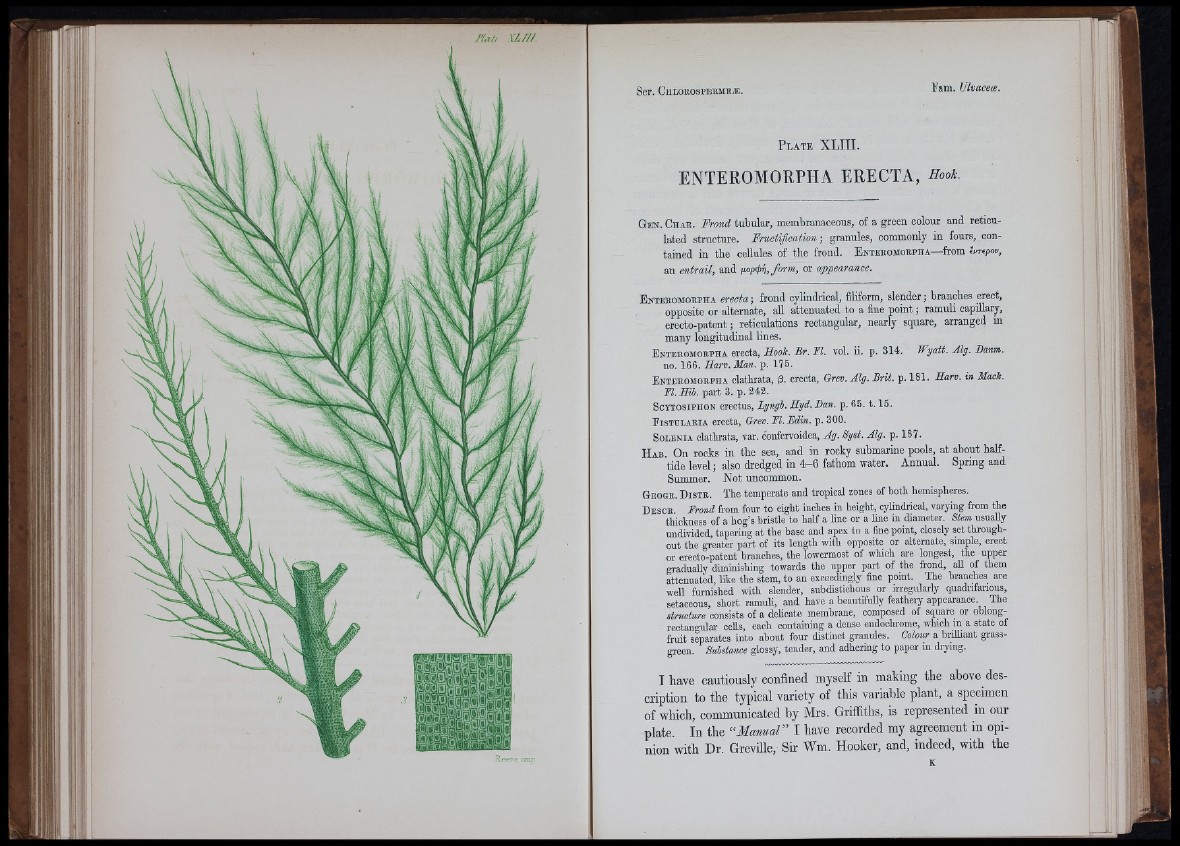
FM h .U///
Keeve imp
P l a t e XLIII.
ENTEROMORPHA ERECTA, Hook.
G e n . C h a b . F rond tu b u la r, membranaceous, of a green colour and reticu lated
structure. F ructifica tio n ; granules, commonly in fours, contained
in th e ceUules of th e frond. E n t e b o m o b ph a— from Ivrepov,
an entrail, and poptfifi/orm, or appearance.
E n t e b o m o b p h a erecta ; frond cylindrical, filiform, slender ; branches erect,
opposite or alternate, all attenuated to a fine p o in t; ramuli capillary,
e rec to -p a ten t; reticulations rectangular, nearly square, arranged in
many longitudinal lines.
E n t e r o m o r p h a erecta, Hook. Br. FI. vol. ii. p. 314. Wyatt. Alg. Banm.
no. 166. H a n . Man. p. 175.
E n t e r o m o r p h a clathrata, /3. erecta, Grev. Alg. Brit. p. 181. Harv. in Mack.
FI. Hib. part 3. p. 242.
S c y t o s iph o n erectus, Lyngh. Hyd. Ban. p. 65. 1 .15.
E is t u l a e ia erecta, Grev. FI. Fdin. p. 300.
SoLENiA c la th ra ta , v a r. co n ferv o id ea, Ag. Syst. Alg. p. 187.
H ab. On rooks in th e sea, and in rocky submarine pools, a t about halftide
level ; also dredged in 4 - 6 fathom water. Annual. Sprmg and
Summer. N o t uncommon.
G e o g e . D i s t r . The temperate and tropical zones of both hemispheres.
D e s c r Frond from four to eight inches in height, cylindiical, vai-ying from the
thickness of a hog’s bristle to half a Hne or a line in diameter. Stem usuaUy
undivided, tapering at the base and apex to a fine point, closely set throughout
the gi-eater part of its length with opposite or alternate, simple, erect
or erecto-patent branches, the lowermost of which are longest, the upper
gradually diminishing towards the upper part of the frond, aU of them
attenuated, like the stem, to an exceedingly fine point. The branches are
well furnished with slender, snbdistichous or irregularly quadrifarious,
setaceous, short ramuli, and have a beautifully feathery appearance. The
structure consists of a deficate membrane, composed of square or oblong-
rectangular ceHs, each containing a dense endochrome, which in a state of
fruit separates into about four distinct granules. Colour a brffliant grass-
green. Substance glossy, tender, and adhering to paper in drying.
I have cautiously confined myself in making the above description
to the typical variety of this variable plant, a specimen
of which, communicated by Mrs. Griffiths, is represented in our
plate. In the “Manual” I have recorded my agreement in opinion
with Dr. Greville, Sir Wm. Hooker, and, indeed, with the